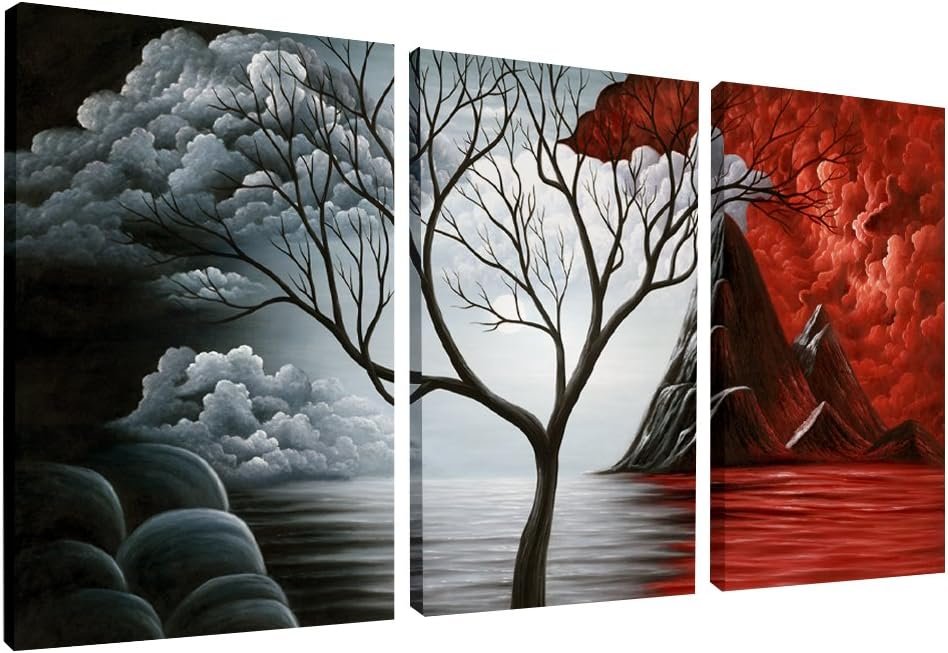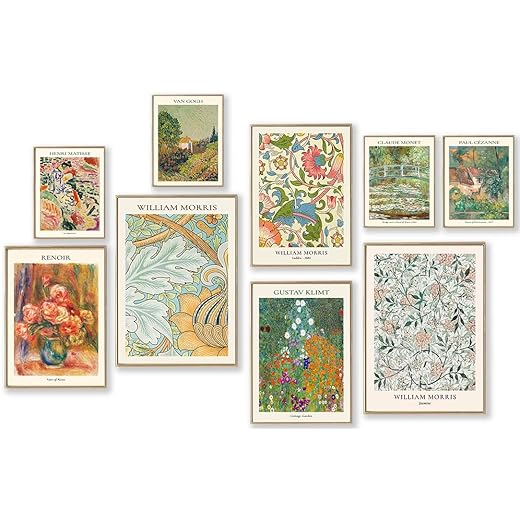Are you feeling a little lost in the vibrant world of modern art? You’re not alone! Many people find themselves drawn to the eye-catching allure of abstract paintings but unsure whether they truly fit their taste or home. In this guide, we’ll delve into the fascinating realm of abstract art, helping you explore its unique styles and emotional depth. Together, we will unravel the elements that make abstract paintings so captivating and discover if they resonate with your personal aesthetic. By the end of this journey, you’ll feel empowered to decide if abstract art is the perfect addition to your space and style. Let’s dive in!
Understanding Abstract Art
Abstract art is a fascinating genre that invites viewers to engage with their emotions and interpretations rather than just representing the physical world. This blog section will dive into the complexities of abstract art, unpack its evolution through key movements, and examine its distinctive characteristics.
What is Abstract Art?
At its core, abstract art moves away from traditional representation. Unlike realistic art—which portrays subjects as they appear in real life—abstract art embraces the idea of forms, colors, and textures as subjects themselves. This form of expression prioritizes emotion, perception, and creativity over recognizable subjects.
Key Characteristics of Abstract Art
- Color: Abstract art often employs bold, vibrant colors or muted palettes to convey feelings. Artists like Mark Rothko were known for their impactful use of color fields, such as in the “Rothko Chapel” series, where deep reds, blacks, and yellows evoke spiritual contemplation.
- Form: The shapes used in abstract art can range from geometric forms, as seen in Kazimir Malevich’s “Black Square,” to organic shapes that defy structure. These forms encourage viewers to interpret the piece in personal ways.
- Texture: Many abstract artists layer paint or use mixed media to create texture. For example, artworks by Jackson Pollock showcase a dynamic surface filled with splatters and drips, making the technique as important as the final composition.
The Evolution of Abstract Art
Expressionism
Emerging in the early 20th century, Expressionism sought to convey emotional experiences rather than physical reality. Artists like Wassily Kandinsky and Egon Schiele used vivid colors and distorted forms to express their inner feelings. Notable works include Kandinsky’s “Composition VII,” where chaotic shapes and energetic colors evoke a sense of turmoil and passion.
Cubism
Developed by Pablo Picasso and Georges Braque, Cubism revolutionized art in the early 20th century by breaking subjects into fragmented forms viewed from multiple perspectives. Picasso’s “Les Demoiselles d’Avignon” exemplifies this movement, featuring angular shapes and a mix of perspectives, which challenged traditional art norms.
Minimalism
Minimalism emerged in the late 1950s, emphasizing simplicity and a focus on the artwork’s essential elements. Artists such as Donald Judd and Agnes Martin stripped down their forms to geometric shapes and monochrome palettes. For instance, Judd’s “Untitled (Stack)” features simple wooden boxes arranged in a meticulous order, inviting viewers to reflect more on the space around them than on the object itself.
Comparing Abstract Art and Representational Art
| Aspect | Abstract Art | Representational Art |
|---|---|---|
| Focus | Emotion and interpretation | Realism and recognizable subjects |
| Form | Non-linear, fragmented | Linear, realistic depiction |
| Color Usage | Bold, emotional | Naturalistic, true to life |
| Viewer Engagement | Open-ended interpretation | Clear narrative or subject |
Practical Examples of Abstract Art
Here are specific brands and products that embrace the hallmark qualities of abstract art:
- Rothko Canvas Prints: Many artists and retailers offer canvas prints inspired by Mark Rothko’s work. Websites like Art.com or Society6 provide options for consumers looking to adorn their spaces with emotive color fields.
- Miro Wall Tapestries: Renowned clothing brand Anthropologie features tapestries that echo the playful and vibrant abstract styles of Joan Miró, providing a unique way to incorporate art into everyday home decor.
- Kandinsky Puzzle by Ravensburger: These puzzles, like “Composition X,” allow art enthusiasts to engage with abstract art interactively, enhancing their understanding of color and form.
By understanding these components of abstract art, you can start to appreciate not just the beauty of abstraction but also the profound emotional and conceptual depths behind each piece. Hence, the next time you come across an abstract painting, you’ll be equipped with both historical context and artistic vocabulary to engage with it meaningfully.
Assessing Personal Taste
Understanding your personal taste in art can be a transformative experience, not just in how you express yourself but also in how you create a space that feels uniquely yours. Let’s explore some questions and prompts to help guide you through this self-discovery process.
Questions to Reflect On
Begin with some introspective questions to gauge your preferences:
- What are your favorite colors?
- Think about not just the colors you wear, but the colors that resonate with you in life. Do you gravitate towards bold reds and yellows that evoke energy, or do you prefer calming blues and greens?
- Which shapes do you find most appealing?
- Do you enjoy the fluidity of organic shapes, or do sharp, geometric designs catch your eye? Consider how these forms make you feel.
- What emotions do different artworks evoke in you?
- Reflect on pieces that have moved you in the past. Do you feel inspired by a vibrant landscape? Or a somber portrait? Identifying these emotions can help you find artwork that truly resonates.
- Are there specific artists or styles you are drawn to?
- Consider if you prefer the soft brush strokes of Impressionism or the bold patterns of Abstract Expressionism, such as works by artists like Jackson Pollock or Wassily Kandinsky.
Practical Examples for Personal Exploration
To further explore your taste, consider seeking out specific pieces that align with your reflections. Here are a few suggestions:
- Favorite Colors:
- If you love blues and greens, you might enjoy a piece like “Water Lilies” by Claude Monet. Alternatively, you could go for a contemporary piece like “Blue” by the abstract artist Yves Klein.
- Appealing Shapes:
- For those drawn to geometric patterns, check out the work of Piet Mondrian, featuring his iconic color blocks. Brands like Society6 offer prints inspired by such artists that can easily enhance your space!
- Emotional Response:
- If you prefer art that evokes feelings of serenity, look for pieces with soothing landscapes or abstract calming hues, such as “Serenity” by artist Sherree Valentine Daines.
How Abstract Art Complements Various Interior Design Styles
Once you have a better understanding of your tastes, let’s explore how abstract art can fit into your home décor.
Modern Design
Modern design focuses on clean lines and a minimalist palette. Consider incorporating a large-scale abstract piece that features monochromatic colors or sharp shapes. For example, the “Abstract Landscape” series by artist Mark Rothko can create a striking focal point in a living room adorned with light-colored furniture.
Eclectic Style
An eclectic design allows for bold expressions and diverse influences. Abstract art such as the colorful prints available from Artfully Walls enables you to embrace variety and inject personality into your space. Mixing different textures and patterns, including a vibrant canvas, alongside unique furniture pieces will create an inviting atmosphere.
Minimalist Style
For those who appreciate the minimalist style, subtle abstract pieces can serve to enhance the simplicity without overwhelming the space. Consider a serene piece like “White on White” by Kazimir Malevich, which uses subtle textures and shapes to maintain a clean aesthetic.
Key Points to Remember
- Emphasize your unique preferences: Allow your personal sentiments to lead your art choices.
- Explore specific artworks and artists: Don’t just rely on styles; delve deep into the artworks that speak to you.
- Visualize how abstract pieces can complement your interior design: Use the characteristics of various design styles to picture how art fits within your personal space.
By taking the time to assess your personal taste in art, you’ll empower yourself to make informed choices that enhance your environment and reflect your individuality.
Finding Your Place in the World of Abstract Art
In conclusion, exploring abstract paintings can be a rewarding journey for you and your living space. This guide has equipped you with valuable insights into modern art styles and helped you assess your personal tastes. Remember, art is a reflection of your individuality, so don’t hesitate to embrace what resonates with you. By thoughtfully selecting abstract pieces that speak to your preferences, you can create a dynamic and inspiring environment that truly feels like home. Happy decorating!
>> Learn more: Top Tips to Choose a Perfect Sofa for Small Living Room












This article totally nailed it! I’ve always been confused about abstract art, but now I feel like I get it!
I found the section on color theory super helpful! I never thought about how color affects emotions.
Why do I feel like I should just throw some paint on a canvas after reading this? 😂
I love how you broke down different styles. Makes it so much easier for a newbie like me!
Abstract paintings always seemed so random to me, but I see the beauty in them now. Thanks!
Great read! I think I’m finally ready to take the plunge into abstract art for my living room.
Can anyone recommend some good abstract artists? I wanna start my collection!
Really appreciate the tips on how to choose art that fits my style. It’s all about personal connection!